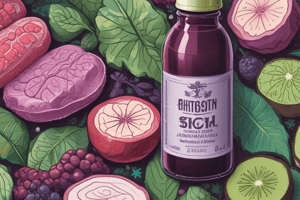Podcast
Questions and Answers
What is the color of the flowers?
What is the color of the flowers?
- Blue
- Yellowish-green (correct)
- Red
- Purple
What is the characteristic of the pollen grains?
What is the characteristic of the pollen grains?
- Oval to slightly triangular and 30-40 um in diameter (correct)
- Triangular in shape and 50 um in diameter
- Circular in shape and 20 um in diameter
- Spherical in shape and 10 um in diameter
What is the main component of the mucilage present in the plant?
What is the main component of the mucilage present in the plant?
- Starch
- Cellulose
- Galactomannans (correct)
- Pectin
What is the function of the plant as an antispasmodic?
What is the function of the plant as an antispasmodic?
What is the function of the plant as a diuretic?
What is the function of the plant as a diuretic?
What is the characteristic of the androecium?
What is the characteristic of the androecium?
What is the characteristic of the gynoecium?
What is the characteristic of the gynoecium?
What is the characteristic of the calyx?
What is the characteristic of the calyx?
What is the characteristic of the corolla?
What is the characteristic of the corolla?
What is the function of the plant in relieving symptoms of the common cold and cough?
What is the function of the plant in relieving symptoms of the common cold and cough?
Flashcards are hidden until you start studying
Study Notes
Anthocyanins
- A spectrophotometric assay for total anthocyanins has been reported
- Delphinidin is an example of anthocyanin
Uses of Anthocyanin-rich Plant
- As a natural coloring agent
- Has beneficial cardiovascular effects (can lower blood pressure by 10-15% in patients with moderate essential hypertension)
- Antioxidant and hypocholesterolemic activities have been reported
- Traditionally, all parts of the plant have been employed as an astringent and cooling agent; it has a diuretic action
Cloves
- Botanical origin: Cloves are obtained from the unexpanded flower buds of Syzygium aromaticum, family Myrtaceae
- Synonyms: Caryophyllus aromaticus, Eugenia aromatica, Eugenia caryophyllata, Eugenia caryophyllus
Morphology of Cloves
- The flower buds are reddish brown in color
- The lower stalk-like portion is called hypanthium, while the upper is a crown or cap-shape
Characters of Cloves
- The easily broken, crimson to violet drug consists of the flower portions comprising a pitcher-shaped calyx
- The powder, examined microscopically, exhibits colored parenchymatous cells containing cluster crystals of calcium oxalate, mucilage-containing cells, vascular tissue, epidermal cells, anisocytic stomata, non-glandular trichomes (alembic and cottony), a few glandular trichomes and pollen grains with spiney exines
Constituents of Cloves
- A considerable quantity of free acids including citric, tartaric, and malic acids and the lactone of hydroxycitric acid
- Anthocyanins: such as the glycosides of delphinidin and cyanidin
- The Pharmacopoeia specifies an absorbance of not less than 0.35 for the whole drug and not less than 0.25 for the cut drug when measured at 520 nm in a prescribed aqueous extract
Microscopic Elements of Cloves
- Mucilaginous cells of the sepals and petals
- Small clusters of calcium oxalate crystals
- Oval to slightly triangular pollen grains, 30–40 um in diameter and having three germinal pores
Bioactive Principles of Cloves
- Flavonoid glycosides: quercetin glycosides (rutin, hyperoside), kaempferol glycosides (tiliroside, astragalin)
- Mucilage: present chiefly in the bracts and consists largely of galactomannans
- A small proportion of volatile oil (c. 0.02–0.1%) containing farnesol, farnesyl acetate, geraniol, and eugenol
- Phenolic acids: chlorogenic acid
Effects and Medicinal Uses of Cloves (Traditional)
- Used for the relief of symptoms of common cold and cough
- Used to relief of mild symptoms of mental stress
- Antispasmodic
- Diuretic (increase urine production)
Studying That Suits You
Use AI to generate personalized quizzes and flashcards to suit your learning preferences.




